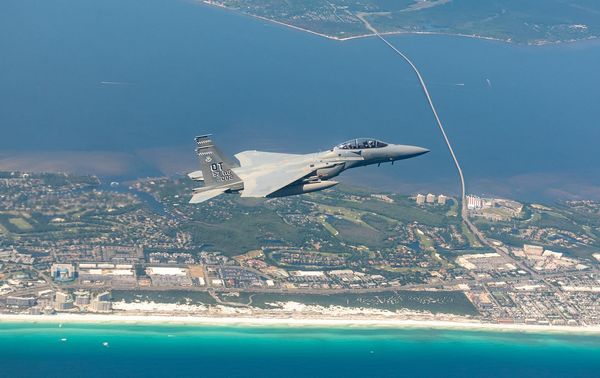Both of the Air Force’s new F-15EX Eagle II fighters will fly in the Northern Edge exercise in Alaska next week to participate in broader joint all-domain command and control experiments, 11th Air Force Commander Lt. Gen. David A. Krumm said April 28. The jets will also employ their new electronic warfare suites in the wargame.
“We’re bringing up F-15EX … with its capabilities, including the EPAWSS,” or Eagle Passive Active Warning Survivability System electronic warfare suite, to participate in Northern Edge 2021, Krumm said from Joint Base Elmendorf-Richardson, Alaska, during an AFA “Air and Space Warfighters in Action” streaming event. The first of the two aircraft departed April 28 from Eglin Air Force Base, Florida, where they are in both developmental and operational testing. Both aircraft were delivered earlier this month from Boeing Co. They will operate out of JBER for the wargame.
The exercise will include “every aspect of JADC2,” Krumm said. Experimental systems include SpaceX Starlink satellites, new remote satellite terminals from the Air Force’s Rapid Capabilities Office—which manages the Advanced Battle Management System—as well as “different technologies in the electromagnetic spectrum, jamming with radars, … [and] a whole array” of new experiments. The Navy’s USS Theodore Roosevelt aircraft carrier is in Alaskan waters for the exercise, he noted.
Krumm said he couldn’t be too specific about what will be tested because “a lot of what we want to do, we’re still working on.” He said Gen. Kenneth S. Wilsbach, head of Pacific Air Forces, will be “uber-focused on ‘how do I connect all these sensors and shooters together?’” The wargame should “advance JADC2,” Krumm said.
Asked what will happen to experimental systems that prove useful in the wargame, Krumm acknowledged, “There’s no doubt, we’ve seen these in the past, where we’ve said how great [an experimental system] was and then it disappeared. Our objective in this is to say, ‘What really contributes? What is really worth pursuing and getting into?’”
The participants are “coming up here with a lot of ideas. We’re going to see which ones work, which ones contribute to the battle space and help our Airmen and Guardians, Soldiers, Sailors, and Marines get more lethal. And we’re going to push that,” Krumm said.
While he expects that “there will be leave-behind” ideas, “what I don’t want is a series of one-off experiments that are [their] own little island in the middle of our capabilities,” he said. Coming from a recent acquisition job, Krumm said he understands “we have to prioritize” which systems to pursue and that “we will work closely” with the acquisition directorates “in determining what things we need to go after” and whether they can be afforded within operations and maintenance budgets. “The possibilities are endless, … but we do need to be picky,” he said.
Krumm said there has been a “significant increase” in Russian aircraft entering the Alaska air defense identification zones, with more than 60 aircraft intercepted in the past year, noting even more than that were “monitored” by 11th Air Force.
Many of the intercepts are run by F-22s out of Elmendorf, and the jet is “employed masterfully by our Airmen,” he said, but its special stealth and agility attributes aren’t essential to the mission. Krumm acknowledged that the F-22 is the “frontline fighter” of the Air Force and that “there is a strain” on Raptor units—as well as on KC-135s and E-3 AWACS—imposed by the intercept mission.
“We use the F-22s because we have them located here,” but “I can see in the future that there would be some other opportunities” for performing the mission with a different aircraft.
“Can we do that differently? We can, but I don’t know all the options we’re going to pursue, yet. I know that any Air Force unit I bring up here would be able to do those intercepts with the same professionalism and proficiency as we have.”
Krumm also said the F-35s that have been bedded down at Eielson Air Force Base, also in Alaska, are performing well. The first unit has 25 airplanes, and a second unit has its first aircraft, and they have been achieving excellent mission capable rates, he reported.
“Right now, the Airmen—the ‘Icemen’—of Eielson are absolutely kicking butt and taking names,” Krumm asserted. The F-35s are “working really, really well,” he reported, noting than in a recent generation exercise, the unit “generated every single F-35 that they had. Every one, all 25 … on the flight line, ready to go. Just an amazing effort.”
While “we certainly have been impacted in some ways by some of the [F-35’s] sustainment issues,” the Airmen at Eielson have adapted the aircraft to operating in extreme cold, sometimes 50 degrees below zero, Krumm said. “No one has put the F-35 in that environment” and operated routinely before, he said. Crews have also modified the aircraft’s survival kit to creatively pack and add more gear to help downed Airmen if they bail out in such conditions.
Northern Edge runs May 3-14.

